[Ark Royal Games, Color Computer]
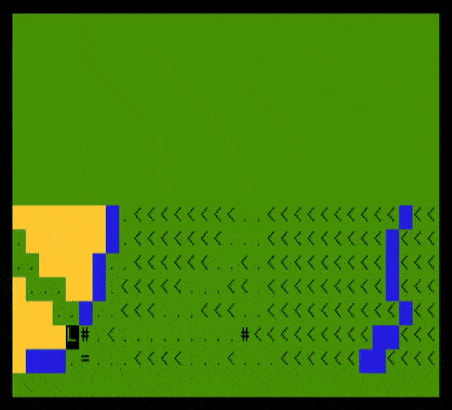
Some of the gifs in this article are captured at warp speed and then slowed down by 25%
Ark Royal Games has a quasi-monopoly on wargames for the Color Computer, a fact on which I have mixed feelings, because while their games offer the best (Guadalcanal) and the worst (Kamikaze) in terms of ruleset design, they are consistently marred by unintuitive controls and game-breaking bugs. In 1982 and 1983, all the Ark Royal Games were, to my knowledge, developed by the co-founders: Phil Keller and David W. Cochran; but this changed in 1984 with two new names:
- Steve Berry, whose CINCPAC – The Battle of Midway did not make a splash. He would not return.
- Carl Carpenter, who seems to have been around for a while and to whom we owe today’s game: Battle of the Bulge.
The Battle of the Bulge is a battle I don’t need to introduce and we can jump directly to the action. For once, the only available faction in solitaire is the “defensive” one – the allies, so my objective is to stop the Germans and prevent them from crossing the Meuse.

Unlike many Battle of the Bulge games, the Germans don’t have a strong opening hand. In theory, they have 10 Panzer units, with their SS Panzer units being the best in the game (strength 25 vs 20 for the allied equivalent), but in practice when the game starts on the 16th of December, they have only 5 of them available – the rest will arrive piecemeal during the battle. The allies on the other hand will have all their forces on the battlefield by day 3. Even worse for the Germans, their infantry is less numerous and 20% worse than the allied Infantry.
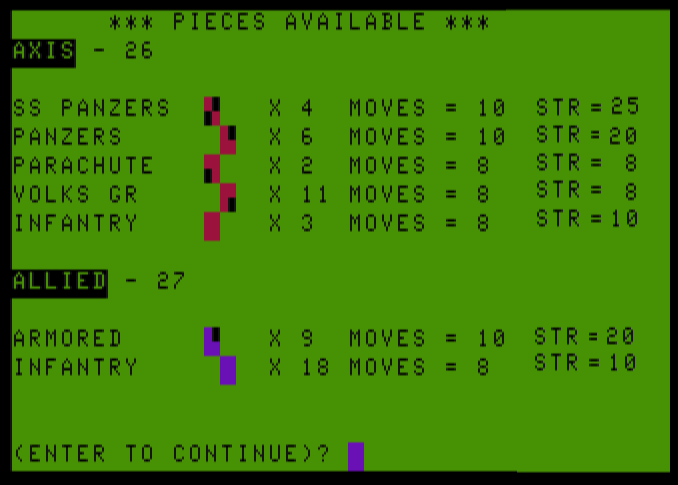
The geography does not help the Germans either: the map is huge, and their objective is either to take Liège [L] or to cross the Meuse (the river separating the green and the yellow area) so all their units starting in the South of the map are out of position.

That does not dissuade the Germans, and they start moving:
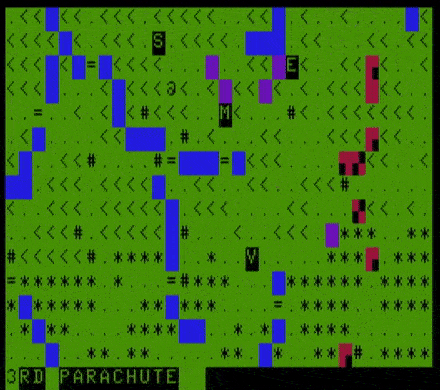
I’d like to write a systematic report on how I stopped the Germans, but this time I will remain high-level, for two reasons:
- The first one is that I don’t think I can keep your interest for a full campaign 🙂
- The second is that on most of the map, unit density is extremely low. There is no zone of control either, and the Germans are actively avoiding my units, so there isn’t much to show in the first place.
In a few specific areas however, there are a few more troops, with in particular a German closing on the area between Elsenborg [E] and Malmedy [M]. Unfortunately for the Germans, this makes them particularly vulnerable to artillery, which all my infantry units can call once every turn as long as they have 4 or more in strength; it randomly scores hits in a 3v3 area.
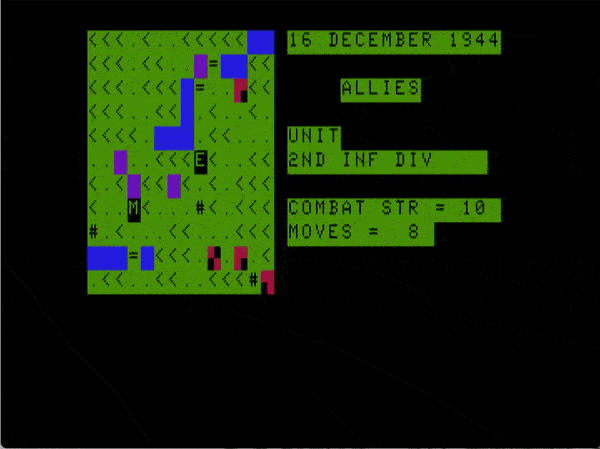
All those units that the Germans bypass can launch artillery attacks. I can even move a bit before pointing a target, so the Germans never get a respite and I spend most of the 16th of December requesting artillery all around.
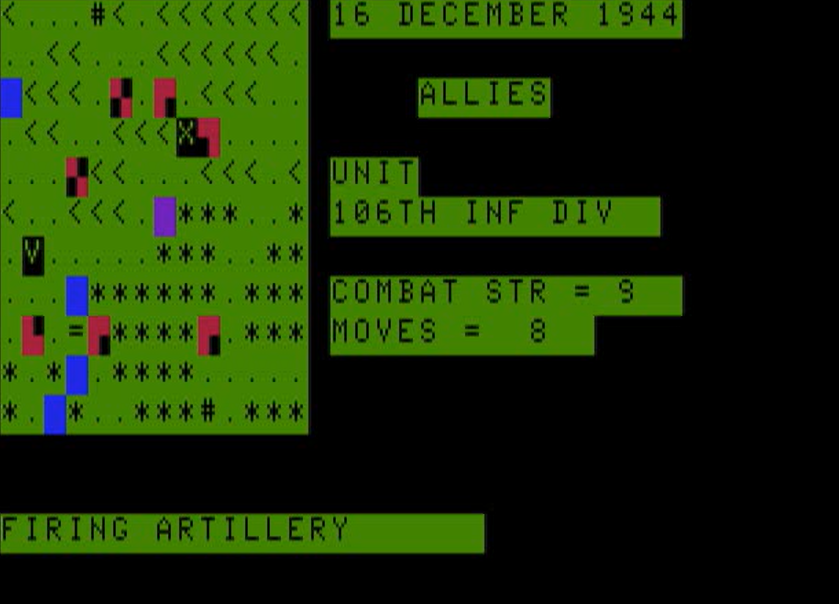
The only drawback of using artillery systematically is that it “consumes” one combat strength forever. Obviously, this is a balancing decision because narratively it’s hard to justify. While big guns have limited ammo and lifespan, the combat value of the rest of your units should not go down as they use artillery. In Battle of the Bulge however, your units can consume themselves over time simply by using artillery.

Overall, the Germans attack through three different prongs that I will cover one after the other:
- The most dangerous German offensive is the one taking the most direct route to Liège. The Germans allocate their two SS elite panzer divisions and various infantry units. I try to build a wall of units near Elsenborg, but the Gruppe Peiper bypasses it by a bridge I could not defend fast enough. It then reaches a “&” terrain icon, which I discover to my horror is the supply depot mentioned in the manual – as long as the Germans don’t capture it they may have fuel issues that slow them down.
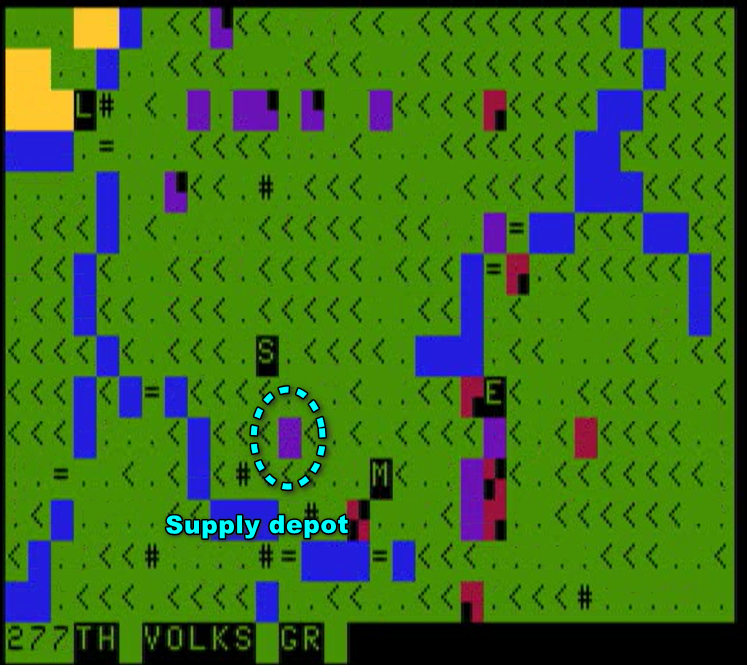
The supply depot is captured and I continue to underestimate the Pieper group. With 2 US Armor units to throw at it and more British Armour coming from the North to protect Liège, I am confident I can use my infantry elsewhere. Unfortunately, when I attack the Pieper group, my US Armor units are pushed back with massive losses: respectively 11 and 9 strength points, for casualties on the German side of only 6 in strength!
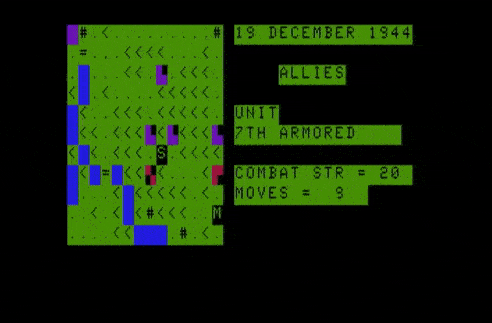
This leaves a very determined and very powerful German SS Panzer unit very close to Liège, with no infantry on my side to chip its strength points from a distance. I pivot my tactics, and stop attacking, stopping my unit on the roads leading to Liège. This forces the SS Panzer unit to pass through the mountain tiles to avoid combat. It slows them down somewhat, but also allows the rest of the SS Panzers to catch up after they broke through my barrage in Elsenborg. At least, I have pummeled them with artillery, so they are not adding a lot of strength points to my enemy.
The 21st of December, the Panzers reach the outskirts of Liège where I mount a firm defense: two (almost) full strength infantry. Peiper’s Panzers are at this point largely depleted, so it should be good enough.
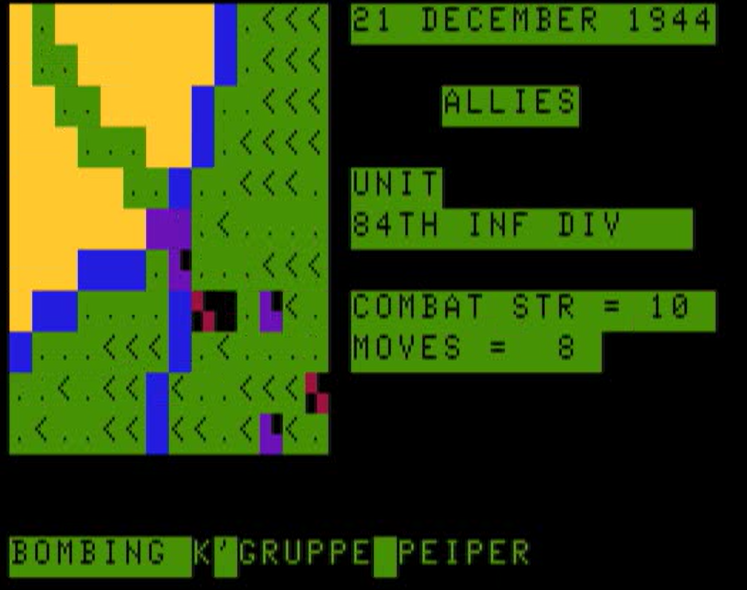
And then, on the 22nd, the Panzers advance and win:

Well! I am sorry but I disagree with this. I don’t think the Germans reached Liège. I request a video arbitration:

The verdict is clear: The Germans never reached Liège. They stopped one tile in front of it:

Either the area triggering the German victory is ill-defined in the code, or the Peiper group did a last movement to Liège that did not have the time to be displayed, and moving to Liège is enough to win without fighting the defenders. Whatever the case, I am not happy with the outcome, so I reload my game and aggressively attack instead of just waiting for the Germans. It works, and Peiper’s group is pushed back. That’s the German high-tide in this alternate history where I don’t lose, and I mop-up the rest of the German forces in the area over the next two days.
- The second prong is a German attempt to reach Bastogne through a bridge, presumably to pivot North. I’ll never know their plans however, because their strategy is thwarted and will be until the end of the game by an American infantry unit standing on the bridge and some American tanks counter-attacking any German foolish enough to try to ford the river without a bridge. And that’s all there is to say about this second prong.
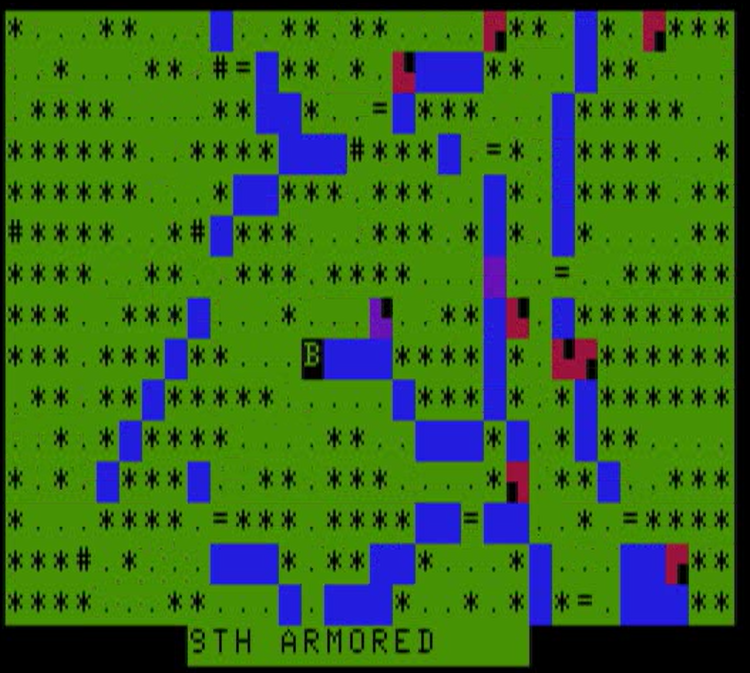
- Finally, the last German effort is an attempt by two non-SS Panzer groups to take a scenic route to avoid my units and pass the Meuse at Namur (N). They approach it on the 19th of December and all I have to oppose them is one US Para unit. Learning from Liège, I occupy the road in front of them, forcing the combat-adverse and nature-loving German tanks to trek the mountains. It slows them down enough that I deploy the last British reinforcements I receive (2 British Armoured units and some infantry) in the area.

I make sure to keep a tank unit fresh and positioned right in front of Namur. The rest of my units whittle down the Germans with artillery (for the infantry) or by positioning in a way where no amount of mountaineering can save the Germans from having warm social interaction with my troops.
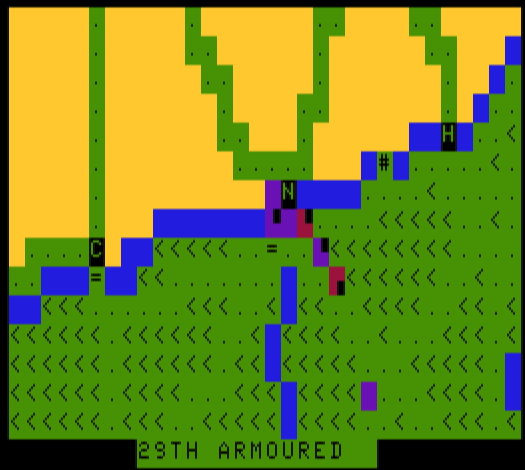
I have a brief moment of stress on the 24th (turn 9) when the Germans try to ford the Meuse…

… but this move reeks of despair: their unit is totally exhausted, and it is destroyed by an attack by my fresh British units, ending the threat in the area.
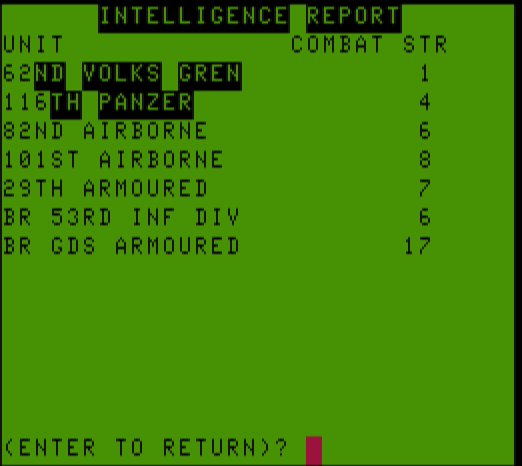
This is the end of the German attack. The remaining 4 turns are spent tracking and destroying the remaining German units, either armored latecomers who beelined toward the Meuse and met my units going the other directions, or infantry division doing nothing useful. I end the game turn 13; I let you judge whether my reload was “fair” or not.
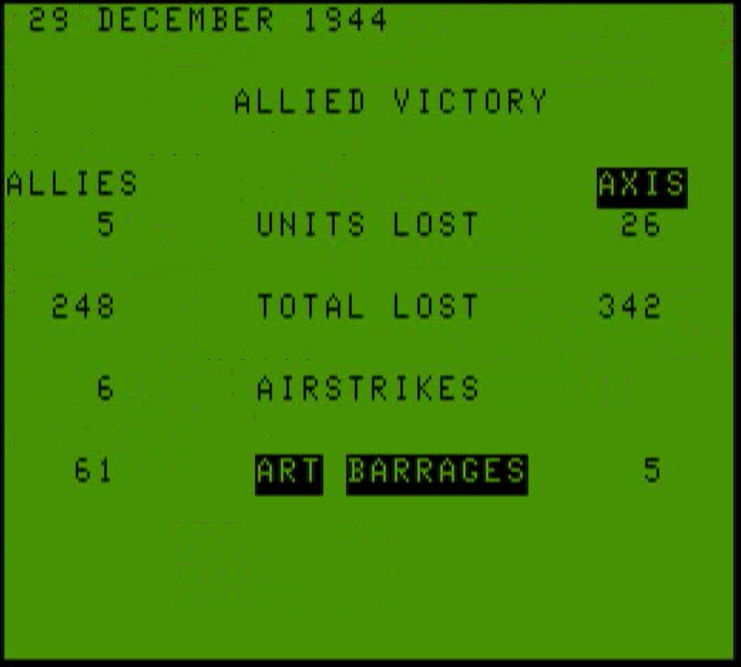

Battle of the Bulge’s review
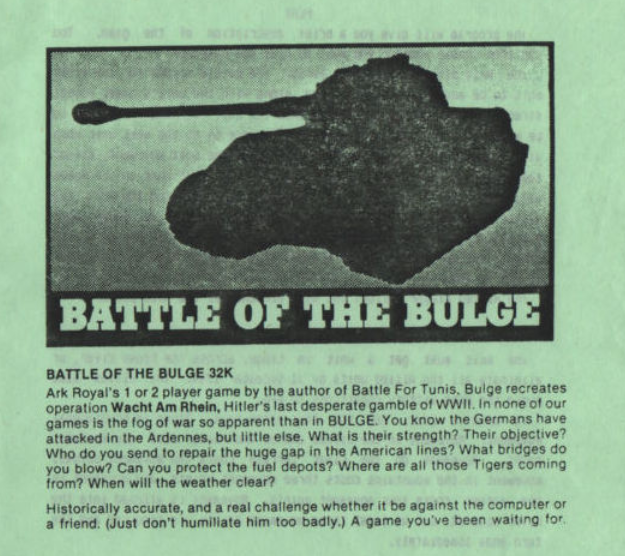
Battle of the Bulge by Carl Carpenter, published by Ark Royal Games, USA
First release: November 1984 for Color Computer
Genre: Combined Arms Tactics
Average duration of a campaign : 2.5 hours
Total time played: 2.6 hours – there is this reload
Complexity: Low (1/5)
Rating: One star
Ranking at the time of review: 37/149
Context – As usual for Ark Royal Games, I don’t have much intel there. Battle of the Bulge was released in November 1984 and was the second game by Carl Carpenter. The first one, Battle for Tunis, had been released earlier in August 1984 but I had skipped it due to the lack of manual. However, I found out that it uses the same engine as Battle of the Bulge and has the same “help menu” explaining the rules, so I am going to cover it. As for Carl Carpenter himself, I could not find any information on him, except that he continued to release games through Ark Royal until at least 1986.
Traits – Battle of the Buldge is an easy to play beer-and-pretzel wargame that feels only distantly related to the Battle of the Bulge: no air force, no weather, artillery lobbing US servicemen strapped with grenades and finally a combination of high freedom of movement and low-unit density. This made me underestimate both the game and my AI opponent. Over time though, I learned to respect the competent strategic AI which aggressively navigated towards its targets with most of its force; too bad it also made poor tactical decisions and ordered the rest of its units to loiter uselessly. The game was challenging, technically I even lost.
While significantly more bug-free than its predecessors, Battle of the Bulge keeps that one irritating Ark Royal Games feature that has rattled me since Rubicon: the lack of explanation on how battles are resolved. Battles feel random, not only on the result (win/loss) but on the amount of losses: sometimes you win a battle and lose 5 strength points, and sometimes you lose a battle and lose only 1 strength point. Generally speaking, I wish the UI was more modern and allowed me in particular to freely navigate the map.
Did I make interesting decisions? Yes, every turn, of two types:
- Should I do a full infantry movement or should I do a half-movement to use my artillery?
- Should I block the road or should I counter-attack?
There was also a higher-level decision on where to allocate the reinforcements and I almost lost by not leaving the 101st Para in Namur. There was tension for most of the game, so my decisions mattered indeed.
Final rating – One star. Battle of the Bulge is an awful simulation of the battle of the same name, but as a game it is easy to pick up and offers a solid challenge that will keep you on your toes, provided you accept a subpar UI and high combat randomness. It’s certainly better than SSI’s Tigers in the Snow, though (spoiler) not as good as the upcoming Breakthrough in the Ardennes.
Reception
Battle of the Bulge received the traditional review in Rainbow Magazine, this time in August 1985. Its author, Stuart Hawkinson makes several comments similar to mine, observing that the real Battle of the Bulge was largely won in the air, which the game ignores. He also complains about the lack of a save feature for a long game. He reckons however that “the Axis forces conduct a respectable Blitzkrieg, moving relentlessly toward their goal.” For this reason, Hawkinson concludes positively: “I don’t usually like “involved” war games, but Battle of the Bulge is an exception. The action is intense, the play is challenging and the outcome is never certain.” As for myself, I am looking forward to testing Battle for Tunis.